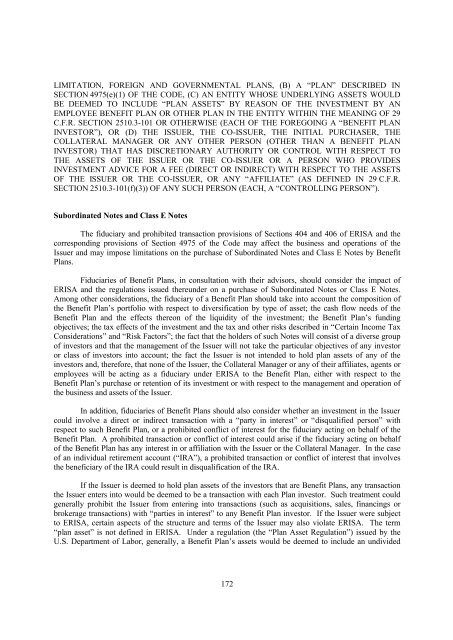Attentus CDO I Offering Circular - Irish Stock Exchange
Attentus CDO I Offering Circular - Irish Stock Exchange
Attentus CDO I Offering Circular - Irish Stock Exchange
Create successful ePaper yourself
Turn your PDF publications into a flip-book with our unique Google optimized e-Paper software.
LIMITATION, FOREIGN AND GOVERNMENTAL PLANS, (B) A “PLAN” DESCRIBED IN<br />
SECTION 4975(e)(1) OF THE CODE, (C) AN ENTITY WHOSE UNDERLYING ASSETS WOULD<br />
BE DEEMED TO INCLUDE “PLAN ASSETS” BY REASON OF THE INVESTMENT BY AN<br />
EMPLOYEE BENEFIT PLAN OR OTHER PLAN IN THE ENTITY WITHIN THE MEANING OF 29<br />
C.F.R. SECTION 2510.3-101 OR OTHERWISE (EACH OF THE FOREGOING A “BENEFIT PLAN<br />
INVESTOR”), OR (D) THE ISSUER, THE CO-ISSUER, THE INITIAL PURCHASER, THE<br />
COLLATERAL MANAGER OR ANY OTHER PERSON (OTHER THAN A BENEFIT PLAN<br />
INVESTOR) THAT HAS DISCRETIONARY AUTHORITY OR CONTROL WITH RESPECT TO<br />
THE ASSETS OF THE ISSUER OR THE CO-ISSUER OR A PERSON WHO PROVIDES<br />
INVESTMENT ADVICE FOR A FEE (DIRECT OR INDIRECT) WITH RESPECT TO THE ASSETS<br />
OF THE ISSUER OR THE CO-ISSUER, OR ANY “AFFILIATE” (AS DEFINED IN 29 C.F.R.<br />
SECTION 2510.3-101(f)(3)) OF ANY SUCH PERSON (EACH, A “CONTROLLING PERSON”).<br />
Subordinated Notes and Class E Notes<br />
The fiduciary and prohibited transaction provisions of Sections 404 and 406 of ERISA and the<br />
corresponding provisions of Section 4975 of the Code may affect the business and operations of the<br />
Issuer and may impose limitations on the purchase of Subordinated Notes and Class E Notes by Benefit<br />
Plans.<br />
Fiduciaries of Benefit Plans, in consultation with their advisors, should consider the impact of<br />
ERISA and the regulations issued thereunder on a purchase of Subordinated Notes or Class E Notes.<br />
Among other considerations, the fiduciary of a Benefit Plan should take into account the composition of<br />
the Benefit Plan’s portfolio with respect to diversification by type of asset; the cash flow needs of the<br />
Benefit Plan and the effects thereon of the liquidity of the investment; the Benefit Plan’s funding<br />
objectives; the tax effects of the investment and the tax and other risks described in “Certain Income Tax<br />
Considerations” and “Risk Factors”; the fact that the holders of such Notes will consist of a diverse group<br />
of investors and that the management of the Issuer will not take the particular objectives of any investor<br />
or class of investors into account; the fact the Issuer is not intended to hold plan assets of any of the<br />
investors and, therefore, that none of the Issuer, the Collateral Manager or any of their affiliates, agents or<br />
employees will be acting as a fiduciary under ERISA to the Benefit Plan, either with respect to the<br />
Benefit Plan’s purchase or retention of its investment or with respect to the management and operation of<br />
the business and assets of the Issuer.<br />
In addition, fiduciaries of Benefit Plans should also consider whether an investment in the Issuer<br />
could involve a direct or indirect transaction with a “party in interest” or “disqualified person” with<br />
respect to such Benefit Plan, or a prohibited conflict of interest for the fiduciary acting on behalf of the<br />
Benefit Plan. A prohibited transaction or conflict of interest could arise if the fiduciary acting on behalf<br />
of the Benefit Plan has any interest in or affiliation with the Issuer or the Collateral Manager. In the case<br />
of an individual retirement account (“IRA”), a prohibited transaction or conflict of interest that involves<br />
the beneficiary of the IRA could result in disqualification of the IRA.<br />
If the Issuer is deemed to hold plan assets of the investors that are Benefit Plans, any transaction<br />
the Issuer enters into would be deemed to be a transaction with each Plan investor. Such treatment could<br />
generally prohibit the Issuer from entering into transactions (such as acquisitions, sales, financings or<br />
brokerage transactions) with “parties in interest” to any Benefit Plan investor. If the Issuer were subject<br />
to ERISA, certain aspects of the structure and terms of the Issuer may also violate ERISA. The term<br />
“plan asset” is not defined in ERISA. Under a regulation (the “Plan Asset Regulation”) issued by the<br />
U.S. Department of Labor, generally, a Benefit Plan’s assets would be deemed to include an undivided<br />
172

















